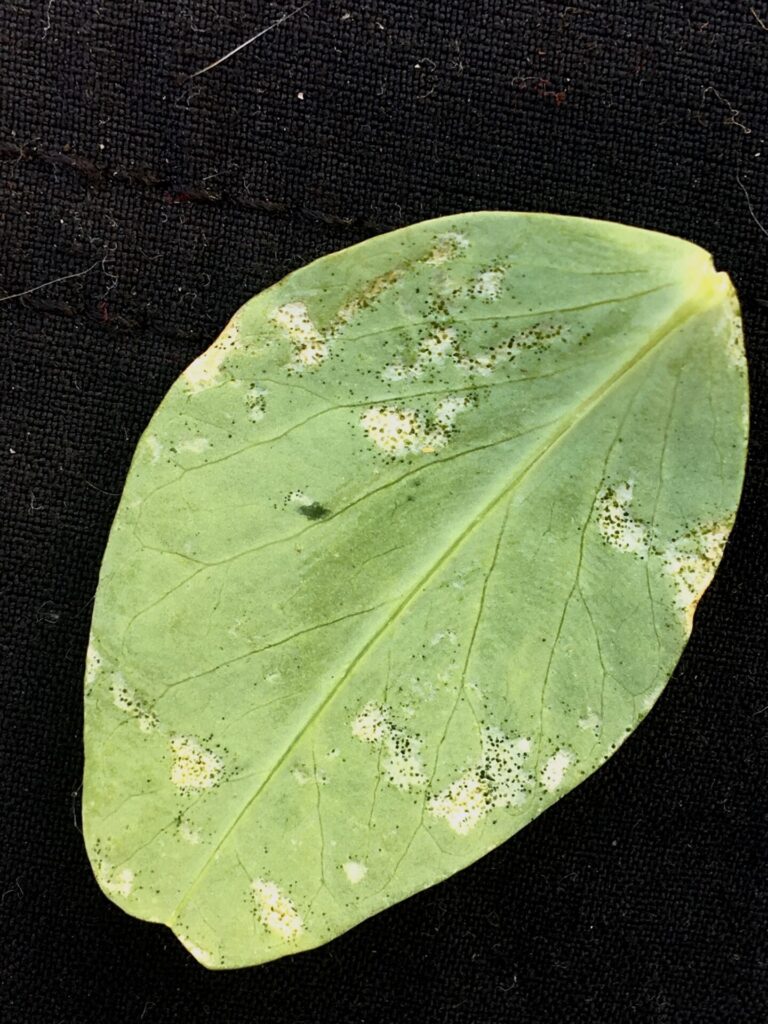
I grow on a small second-storey deck in Toronto where I have a series of cages (for plants to be trellised and/or protected from squirrels) and shelves with various containers on them. At the very bottom of the shelves, we have an experimental window box where we just let whatever from last year come up to grow, plus some clover seeds we tossed in earlier in the season. I noticed that there was quite a few forget-me-nots popping up but let them be. The result is it’s pretty densely planted. Recently I noticed some of the clover in the corner started to develop white flecks all over it but it didn’t seem to be spreading so I didn’t get alarmed. Well, now it looks like those white flecks are on about half of the peas in the planter box beside it, with what appear to be black spores beneath those flecks on the underside of the leaves. I’m thinking it’s a fungus, but would greatly appreciate anyone who might be able to recognize it and recommend a treatment. The peas are done producing anyways, so tearing them out isn’t the end of the world. I did notice that a lot of these tiny black spots on the pea leaves seem to be concentrated on either the undersides of the leaves or on parts where the leaves touch the chicken wire cage. The photo is of the underside of a snow pea leaf.
Thank-you for contacting Toronto Master Gardeners with your question.
You are correct in thinking that the white spots are evidence of a fungal growth, most likely powdery mildew. This fungal disease infects many plants, including peas. There are many types of powdery mildew, each specific to particular plants or plant groups. Both clover and peas are members of the Fabaceae (legume) family. That is why the fungus was able to move from the clover to the peas. (If you are growing beans as well, examine them closely because they are also Fabaceae family members.) Powdery mildew spreads readily in warm, humid conditions. Spores are wind-born, and, unlike other fungi, they do not require water to germinate.
Treating fungal outbreaks with an organic fungicide can help to control the spread of powdery mildew but it is only effective if you are able to catch the infection right at the start. It would not be effective in your situation, given that the mildew has advanced significantly. The most effective treatment for a powdery mildew outbreak is to remove all infected plant material. This is often impossible if the mildew has attacked perennials, woody plants or fruits and vegetable that are yet to produce or in production. You are fortunate that the disease struck your peas after they had produced (the advantage of an early, cool-season crop). You should carefully remove all of the infected plants (both peas and clover) and dispose of them in the City green bin (where they will be composed at high temperature). Make sure to disinfect any tools you use to remove the plants.
There are a few issues you should address to avoid an outbreak of powdery mildew next year. First, and foremost, clear away all garden debris in the fall so that fungus spores do not have a place to over-winter. Secondly, try to choose mildew-resistant varieties for your plantings. Finally, try to improve air circulation in your container and trellis/cage situations. Dense, humid situations foster the growth of all types of fungus.
The following references provide useful information about powdery mildew, its control and prevention:
https://www.gardeningknowhow.com/edible/vegetables/peas/controlling-powdery-mildew-in-peas.htm
https://www.rhs.org.uk/advice/profile?pid=253
https://www.thespruce.com/powdery-mildew-1402500
Good luck with your experimental box and a thorough fall clean-up!

